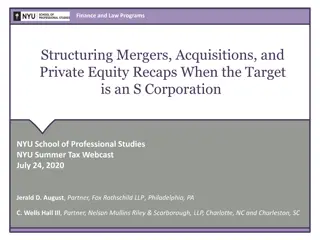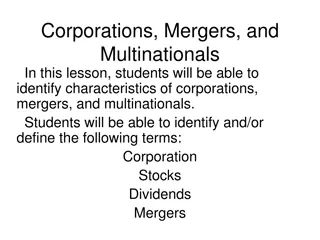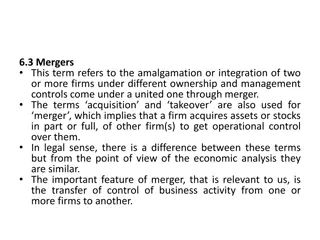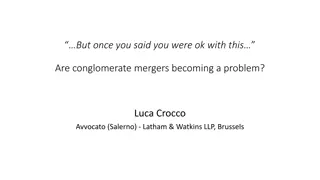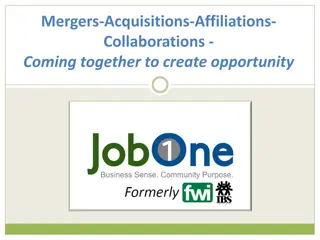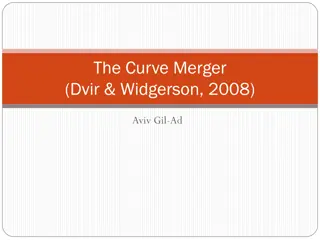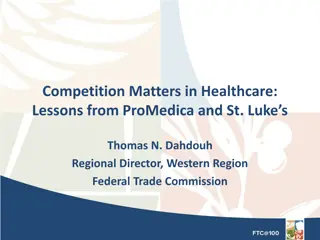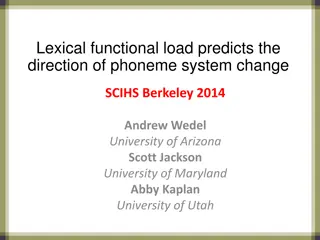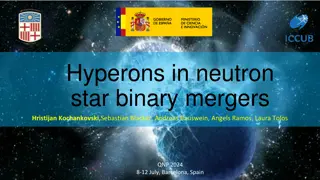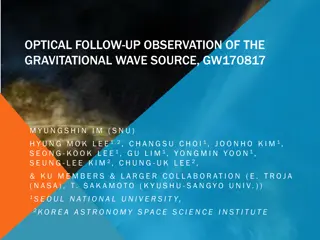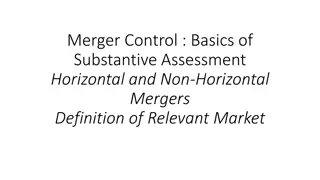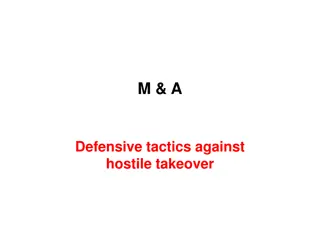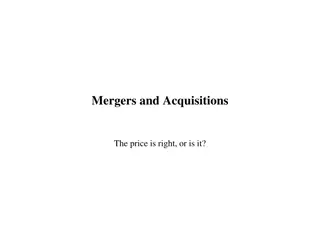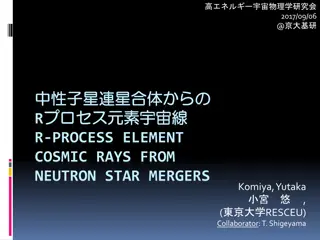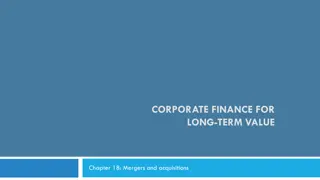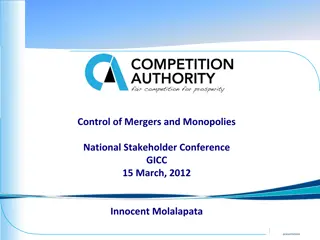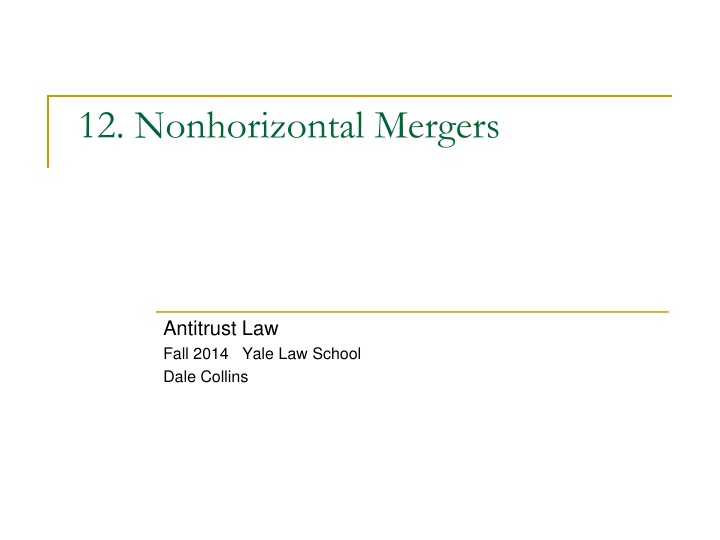
Antitrust Law Fall 2014 Yale Law School
Explore the implications of non-horizontal mergers, vertical foreclosure, and theories of anticompetitive harm based on potential competition in the context of Antitrust Law at Yale Law School during the Fall of 2014. Discover how potential competition can impact market dynamics, acquisitions, and competition strategies.
Download Presentation

Please find below an Image/Link to download the presentation.
The content on the website is provided AS IS for your information and personal use only. It may not be sold, licensed, or shared on other websites without obtaining consent from the author. If you encounter any issues during the download, it is possible that the publisher has removed the file from their server.
You are allowed to download the files provided on this website for personal or commercial use, subject to the condition that they are used lawfully. All files are the property of their respective owners.
The content on the website is provided AS IS for your information and personal use only. It may not be sold, licensed, or shared on other websites without obtaining consent from the author.
E N D
Presentation Transcript
12. Nonhorizontal Mergers Antitrust Law Fall 2014 Yale Law School Dale Collins
Topics Eliminating potential competition Vertical foreclosure Vertical information conduits Antitrust Law Fall 2014 Yale Law School Dale Collins 2
Eliminating Potential Competition Antitrust Law Fall 2014 Yale Law School Dale Collins 3
Eliminating potential competition Theories of anticompetitive harm based on potential competition1 Actual potential competition Acquire a firm that that otherwise would have entered the market, reduced concentration, and increase competition Acquisition eliminates in increase in future competition Not yet approved by the Supreme Court Agencies have used to obtain consent decrees when: The market is highly concentrated Entry is almost certain in the immediate future Typical application: Pharmaceutical acquisition of a company with a competitive product near the end of the FDA approval process Actual potential entrant Theory: Entry would deconcentrate an oligopolistically performing market and make it more competitive 1 Many courts and commentators regard the elimination of potential as a theory of conglomerate merger anticompetitive harm, but potential competition is simply likely future horizontal competition and should be treated as such. Antitrust Law Fall 2014 Yale Law School Dale Collins 4
Eliminating potential competition Theories of anticompetitive harm based on potential competition Perceived potential competition Acquire a firm that incumbents fear will enter the market and hence have moderated their prices ( limit pricing ) to discourage that firm from actually entering Acquisition eliminates the threat of entry and incumbent firms no longer have an incentive to moderate prices Theory recognized by the Supreme Court No modern applications almost impossible to show that incumbent firms have engaged in limit pricing to discourage entry Perceived potential entrant Theory: Threat of entry causes incumbent firms in an oligopolistically structured market to perform more competitively Antitrust Law Fall 2014 Yale Law School Dale Collins 5
Theories of anticompetitive harm Elimination of potential competition Under either theory, the potential entrant may be either the target or the acquirer Potential entrant Acquirer Target Scenario 2 Scenario 1 Potential entrant as the target Potential entrant as the acquirer Antitrust Law Fall 2014 Yale Law School Dale Collins 6
Steris/Synergy (2015) Transaction Steris to acquire U.K.-based Synergy for $1.9 billion (39% premium) Tax inversion: Steris to move to the U.K. The parties Steris: The second largest sterilization company in the world Synergy: The third largest sterilization company in the world Gamma sterilization services One of three major types of sterilization services for hospitals Providers: Only two providers in the U.S. Sterigenics (#1), with fourteen gamma facilities in the U.S. Steris (#2), with twelve gamma facilities in the U.S. Collectively account for 85% of all U.S. contract sterilization services (of all types) Synergy Has 36 contact sterilization facilities (primarily gamma facilities) outside of the U.S., but no gamma facilities inside the U.S. But is the largest provider of e-beam sterilization services in the U.S. Operates a commercial x-ray sterilization facility a new technology that competes with gamma sterilization in Daniken, Switerland Antitrust Law Fall 2014 Yale Law School Dale Collins 7
Steris/Synergy (2015) FTC concern: Elimination of actual potential competition Prior to the announcement of the transaction, Synergy had been planning to enter the U.S. with its emerging x-ray sterilization technology Synergy s entry would have provided competition to the Sterigenics-Steris duopoly Synergy will not enter if acquired by Steris No other company appears likely to enter into the gamma sterilization market postmerger District court1 Following a three-day evidentiary hearing, the court denied the preliminary injunction Assumes the elimination of actual potential competition is a cognizable theory Highly concentrated market Alleged potential entrant probably would have entered the market Such entry would have had procompetitive effects Few if any other firms could enter the enter effectively2 Court: The FTC failed to show that Synergy would have entered the U.S. bur for the transaction. 1 FTC v. Steris Corp., No. 1:15 CV 1080, 2015 WL 5657294 (N.D. Ohio Sept. 24, 2015). 2 These are the elements as stated by the FTC in its supporting papers. Most case law supports a more demanding test on the likelihood of entry by the potential entrant and on the likelihood of entry by other firms in the absence of entry by the potential entrant.. Antitrust Law Fall 2014 Yale Law School Dale Collins 8
Nielsen/Arbitron (2012) Transaction Nielsen to acquire Arbitron for $1.26 billion (26% premium) Combined company: About $6.0 billion in revenue Parties Nielsen: Essentially a monopolist in television audience measurement services Arbitron: Essentially a monopolist in radio audience measurement services Cross-platform audience measurement services Both Nielsen (on its own) and Arbitron (through a jv with comScore) were separately developing a service for measuring frequency of unduplicated audience exposure for programming content and advertising across platforms (television, radio, PC, smartphones, tablets) Entry requires a broad-based national audience television panel of known demographics and audience measurement technology Only Nielsen and Arbitron have such panels and audience measurement technology They are very expensive to create and there was no evidence that anyone would create a new one postmerger Antitrust Law Fall 2014 Yale Law School Dale Collins 9
Nielsen/Arbitron (2012) FTC concern Elimination of actual potential competition In the absence of the transaction, Nielsen and Arbitron likely would have developed competing cross-platform audience measurement services With transaction, companies will develop only one service No other company or consortium of companies appears likely to enter into the development of such a service postmerger FTC consent decree Principle: Enable another company to replicate Arbitron s participation in the comScore jv. Requirements Sell Arbitron s Link Meter Technology to an approved divestiture buyer (no buyer upfront) License use of calibration panel, television data, radio data, and calibration panel data for 8 years Provide technical assistance at cost Remove all barriers to hiring key Arbitron personnel Provides for a compliance monitor Permits FTC to appoint a divestiture trustee to sell assets and license technology and data if Nielsen fails to do so within the time limits of the consent decree (3 months) Antitrust Law Fall 2014 Yale Law School Dale Collins 10
Nielsen/Arbitron (2012) Not addressed by the FTC Lessening of innovation incentive Nielsen was perceived by some industry participants as uninterested in innovation and as suppressing the R&D activity of companies it acquired Arbitron was perceived by some industry participants as a more innovative company Industry concern: The rate of Arbitron innovation postmerger would be suppressed Final resolution FTC approved comScore to be the divestiture buyer Antitrust Law Fall 2014 Yale Law School Dale Collins 11
Akorn/VersaPharm (2014) Transaction Akorn to acquire VersaPharm for $324 million Parties Akorn: A niche pharmaceutical company with 2013 revenues of $318 million VersaPharm: Niche company offering 20 generic products with a pipeline of another 20 products Injectable Rifampin Tuberculosis drug No substitutes Only VersaPharm and two other firms currently have FDA approval FTC concern In the absence of the transaction, Akorn likely would have entered the market FTC consent decree Divest Akorn Abbreviated New Drug Application (ANDA) to Watson Laboratories (buyer upfront) Provide Watson with any information the FDA requests and assist Watson in obtaining FDA approval for ANDA Antitrust Law Fall 2014 Yale Law School Dale Collins 12
Vertical Foreclosure Antitrust Law Fall 2014 Yale Law School Dale Collins 13
Vertical foreclosure Paradigm case Combines the only firm producing an essential input With a downstream user in competition with other downstream users Permitting the combined firm to drive its downstream competitors out of the market Essential input supplier s 3 4 1 2 Competitors The combined firm can cut off the essential input from its downstream competitors and monopolize the downstream market Antitrust Law Fall 2014 Yale Law School Dale Collins 14
Vertical foreclosure Variations Either Firm 1 of Firm S could be the acquirer The combined firm raises the price to its competitors rather than foreclosing them altogether There could be several suppliers of the essential factor, but the theory still applies if the postmerger market the competitors are significantly competitively disadvantaged because the other input suppliers are simply higher cost firms, or with the combination it is easier for the other suppliers to oligopolistically coordinate and charge higher prices with the result in either case being that competition in the widget market is reduced. The essential factor could be a distribution or retail channel rather than an input Usual remedies Non-discriminatory access undertakings Undertakings to maintain open systems to enable interoperability Antitrust Law Fall 2014 Yale Law School Dale Collins 15
Comcast/NBCU (2011) Transaction Comcast and General Electric to form a joint venture consisting of NBC Univeral sand Comcast s content and Internet assets JV to be owned 51% by Comcast and 49% by GE Comcast to pay GE $6.5 billion to balance contribution JV to raise $9.1billion of debt, with proceeds to be distributed to GE JV to be managed by Comcast Contributions GE: NBC Universal s businesses (valued at $30 billion), including: The NBC Network (including NBC s 10 owned and operated TV stations)and NBC Sports The NBC cable networks (including USA, Bravo, Syfy, CNBC and MSDNBC) Universal Pictures, Focus Films, and Universal Studios (including the film library) The Universal theme parks Hulu (32% ownership) (an online video distributor or OVD ) Comcast cable network businesses (valued at $7.25 billion), including: Cable networks (including E!, Versus, and the Golf Channel) 10 regional sports networks Certain other digital properties Antitrust Law Fall 2014 Yale Law School Dale Collins 16
Comcast/NBCU (2011) DOJ concerns JV give Comcast control over NBCU s video programming Comcast could limit competition with its cable systems by refusing to license (or, more likely, licensing at higher prices) NBC s essential programming content to Multichannel Video Programming Distributors (MVPDs),1 and Online Video Programming Distributors (OVDs)2 JV gives Comcast control of NBC s 10 O&O TV stations and their local content Comcast could raise fees for retransmission consent for the NBC O&Os or effectively deny this content to certain video distribution competitors of Comcast cable systems JV gives Comcast control over a 32% interest in Hulu Comcast could use its rights to impede Hulu s development as a OVD competitor Likely effects Decreased competition in the development, provision, and sale of video programming distribution services in local geographic markets served by Comcast cable systems Increased prices for video programming distribution services in local geographic markets served by Comcast cable systems Ability to limit content and raise input prices could also reduce the rate of innovation and quality improvement of video programming distributions services 1 Includes cable overbuilders (primarily RSN), direct broadcast satellite services (DirecTV and EchoStar DISH), and telephone companies (e.g., Verizon Fios). 2Includes over the top (OTT) services delivered over the Internet but not through a cable system set-top box. Antitrust Law Fall 2014 Yale Law School Dale Collins 17
Comcast/NBCU (2011) DOJ consent decree1 Traditional competitors Coordinated with the FCC FCC order requires the JV to license NBCU content to Comcast s cable, satellite, and telephone company competitors Not included in DOJ consent decree as redundant Online video distributor competitors Must make available same package of broadcast and cable channels that JV sells to traditional video programming distributors Must offer broadcast, cable, and film content similar to, or better than, distributor receives from JV s programming peers NBC s broadcast competitors: ABC, CBS, Fox Largest cable programmers: News Corp., Time Warner, Viacom, and Walt Disney Largest video production studios: News Corp., Sony, Time Warner, Viacom, Walt Disney Commercial arbitration if cannot reach agreement on license terms Prevents restrictive licensing practices and retaliation Comcast prohibited from unreasonably discriminating in the transmission of an OVD s lawful traffic over Comcast ISP Hulu Comcast to relinquish voting and other governance rights in Hulu Comcast precluded from receiving confidential or competitively sensitive information about Hulu s operations 1 DOJ action joined by five state attorneys general: California, Florida, Missouri, Texas and Washington. Antitrust Law Fall 2014 Yale Law School Dale Collins 18
Vertical Information Conduits Antitrust Law Fall 2014 Yale Law School Dale Collins 19
Vertical information conduits Paradigm case Market is conducive to oligopolistic coordination except that information on which to coordinate is not ready available and the vertical merger provides a mechanism for a information exchange Antitrust Law Fall 2014 Yale Law School Dale Collins 20
Coca-Cola/Coca-Cola Enterprises (2010) Transactions Coca-Cola to acquire CCE s North American operations for over $12.3 billion Separately, Coca-Cola paid Dr Pepper Snapple Group (DPSG) $715 million to distribute DPSG brands (including Dr Pepper and Canada Dry) in specific geographic areas Parties Coca-Cola: The largest manufacturer of oft drink concentrate and carbonated soft drinks CCE: Coca-Cola s largest independently owned North American bottler DPSG: The third largest soft drink competitor after Coca-Cola and PepsiCo Soft drink bottling Soft drink shares: Coca-Cola (40%), PepsiCo (30%), DPSG (17%) Soft drink concentrate manufacturers license bottlers to produce, bottle/can, and distribute the manufacturer s soft drinks in a prescribed geographic area CCE Accounted for 75% of Coca-Cola s U.S. sales of bottled and canned soft drinks Accounted for 14% of DPSG s U.S. sales of bottled and canned soft drinks Antitrust Law Fall 2014 Yale Law School Dale Collins 21
Coca-Cola/Coca-Cola Enterprises (2010) FTC concerns Concentrate manufacturers need to provide their bottlers with advance confidential information regarding their advertising, marketing, and promotion strategies and their new product introductions The DPSG distribution agreement with Coca-Cola did not provide adequate safeguards against access by Coca-Cola s competitive operations to DPSG competitively sensitive and confidential information obtained by Coca-Cola s bottling operations, resulting in: Likely elimination of direct competition between Coca-Cola and DPSG Increase in the probability that Coca-Cola could unilaterally exercise market power or influence and control DPSG s prices Increased in the probability of coordinated interaction Coca-Cola DPSG DPSG competitive sensitive information Coca-Cola bottling Antitrust Law Fall 2014 Yale Law School Dale Collins 22
Coca-Cola/Coca-Cola Enterprises (2010) FTC consent decree Information firewall to Limit access to and use of DPSG competitively sensitive information to Coca-Cola bottling operation for use in the bottling and marketing of the DPSG products Prevent Coca-Cola s competitive operations from gaining access to such information Set procedures for changing bottling operations personnel Imposed a compliance monitor Query Why did the FTC believe that the confidentiality provisions of the DPSG distribution agreement were insufficient? Antitrust Law Fall 2014 Yale Law School Dale Collins 23
Vertical merger efficiencies Eliminating double marginalization This is a major claim of efficiencies in vertical mergers Paradigm example: Conditions Firms M and R are adjacent firms in the chain of distribution, both of which have some market power (i.e., face downward-sloping demand curves). Assume without loss of generality, that Firm M is a manufacturer and Firm R simply resells M s product without modification and that cM and cR are the (constant) marginal costs of production and resale, respectively, for manufacturer M and reseller R. In equilibrium, manufacturer M sells quantity q to reseller R at price pM, which in turn sells the same quantity q to consumers at price pR (i.e., there is no overproduction or inventory holding). Assume that consumer demand is linear and normalize p so that: = q a p . R Manufacturer Marginal cost: c M Sells at price p M Retailer Marginal cost: c R Sells at price p R Consumers = Demand: q a p R Antitrust Law Fall 2014 Yale Law School Dale Collins 24
Vertical merger efficiencies Eliminating double marginalization The retailer s problem: The profit function and first order condition for the retailer R are: ( ( ( ( R R p p a = + ) )( Firm R s marginal cost is its unit input cost pM plus its unit distribution cost cR = + p q p c q Max p R R M R R ) ) = + p p c a p R M R R ) ( + ( ) ) = + R p p c a p M R R ( ) + + = 2 p c 0 R M R ( ) + + a p c = M R so that p R 2 ( ) + a p c = M R q 2 ( ) + a p c ( ) ( ) = + M R p p c R R M R 2 Antitrust Law Fall 2014 Yale Law School Dale Collins 25
Vertical merger efficiencies Eliminating double marginalization The manufacturer s problem: Now consider the profit function and first order condition for the manufacturer M, which understands how retailer R will price the resale and can take this into account when maximizing its own profits: = Max M p p q c q Since retailer R holds no inventory, the demand q for M s product by R is equal to the demand qfor R s products by consumers M M M ( ) + a p c ( ) = M R p c M M 2 ( ) ( ) + p c a p c = + M M M R M p 2 2 M ( ) + + 2 p a c c = = M M R 0 2 ( ) + a c c = M R so that p M 2 ( ) + a c c + M R a c ( ) ( ) R + + 2 2 a p c a c c = = = M R M R q 2 4 ( ) + a c c ( ) ( ) = = M R p c q p c M M M M M 4 Antitrust Law Fall 2014 Yale Law School Dale Collins 26
Vertical merger efficiencies Eliminating double marginalization Total profits of the manufacturer and retailer: ( ) ( ) ( ) + = + + p c q p p c q M R M M R M R ( ) + a c c ( ) ( ) = + M R p c c R M R 4 Antitrust Law Fall 2014 Yale Law School Dale Collins 27
Vertical merger efficiencies Eliminating double marginalization The merged firm s problem: Assume that M and R merge. Keep in mind that the merged firm is a monopolist at both the manufacturer and retailer level. Now consider the profit function and first order condition for the combined firm: ( ) = + Max p pq c c q M R ( )( ( ) ) = + p c c a p M R ( ) = + + = a 2 p c c 0 M R p ( ) + + a c c = M R so that p 2 ( ) + a c c = M R q 2 ( ) + a c c ( ) ( ) ( ) ( ) = + = + M R p c c q p c c M R M R 2 Antitrust Law Fall 2014 Yale Law School Dale Collins 28
Vertical merger efficiencies Eliminating double marginalization Comparing the non-integrated and merged firm solutions Non-Integrated Firm Merged Firm ( ) ( ) + + a c c + + a p c M R M R Price to consumers 2 2 ( ) ( ) + a p c + a c c M R M R Quantity produced 2 2 ( ) ( ) + a c c + a c c ( ) ( ) ( ) ( ) + M R p c c + M R p c c Total profits R M R 4 M R 2 If pM > cM (which it will be so long a q > 0), then the merged firm has lower prices to consumers, higher output, and higher profits than the two firms operating independently. The merged firm has a transfer price pM = cM, that is, the manufacturer within the merged firm prices as if it is in a competitive market and all profits are taken out at the retailer level. Antitrust Law Fall 2014 Yale Law School Dale Collins 29
Vertical merger efficiencies Eliminating double marginalization An example = Demand: Marginal cost (manufacturer): Marginal cost (retailer): Marginal cost (total): q 12 p R = c 3 M = c + 1 = R c c 4 M R Competitive p 4 q 8 Revenues 32 Costs 32 Profits 0 Merged firm p 0 1 2 3 4 5 6 7 8 9 10 11 12 q 12 11 10 9 8 7 6 5 4 3 2 1 0 Revenues 0 11 20 27 32 35 36 35 32 27 20 11 0 Costs 48 44 40 36 32 28 24 20 16 12 8 4 0 Profits -48 -33 -20 -9 0 7 12 15 16 15 12 7 0 Antitrust Law Fall 2014 Yale Law School Dale Collins 30
Vertical merger efficiencies Eliminating double marginalization An example Retailer pM pR mcR-T 0 6.50 1 1 7.00 2 2 7.50 3 3 8.00 4 4 8.50 5 5 9.00 6 6 9.50 7 7 10.00 8 8 10.50 9 9 11.00 10 10 11.50 11 11 12.00 12 12 12.50 13 qR Revenues Costs Profits 30.25 25.00 20.25 16.00 12.25 9.00 6.25 4.00 2.25 1.00 0.25 0.00 0.25 5.50 5.00 4.50 4.00 3.50 3.00 2.50 2.00 1.50 1.00 0.50 0.00 -0.50 35.75 35.00 33.75 32.00 29.75 27.00 23.75 20.00 15.75 11.00 5.75 0.00 -6.25 5.50 10.00 13.50 16.00 17.50 18.00 17.50 16.00 13.50 10.00 5.50 0.00 -6.50 Determined simultaneously with double marginalization Manufacturer pM mcM-T qR Revenues Costs 16.50 15.00 13.50 12.00 10.50 9.00 7.50 6.00 4.50 3.00 1.50 0.00 -1.50 Profits -16.50 -10.00 -4.50 0.00 3.50 6.00 7.50 8.00 7.50 6.00 3.50 0.00 -4.50 Total Profits 0 1 2 3 4 5 6 7 8 9 3 3 3 3 3 3 3 3 3 3 3 3 3 5.50 5.00 4.50 4.00 3.50 3.00 2.50 2.00 1.50 1.00 0.50 0.00 -0.50 0 5 9 13.75 15.00 15.75 16.00Merged firm 15.75 15.00 13.75 12.00Separate firms 9.75 7.00 3.75 0.00 -4.25 12 14 15 15 14 12 9 5 0 -6 10 11 12 Antitrust Law Fall 2014 Yale Law School Dale Collins 31
Vertical merger efficiencies Eliminating double marginalization An example All profits earned at the retailer level (constant marginal cost case) Integrated and Merged Firm Profits 40.00 Non-integrated total profits Merged firm s profits 30.00 20.00 rofits 10.00 0.00 0.00 0.50 1.00 1.50 2.00 2.50 3.00 3.50 4.00 4.50 5.00 5.50 -10.00 -20.00 Output Manufacturer Retailer Total Manufacturer earns no profits maximizes output to retailer (constant marginal cost case) Antitrust Law Fall 2014 Yale Law School Dale Collins 32
Vertical merger efficiencies Retail price 12 pR = 12 q (retail demand) Retail price w/separate firms10 Marginal revenue curve for the independent retailer and also the merged firm Merged firm s retail price Manufacturer price w/separate firms 8 7 cM + cR = 4 (total marginal cost) Competitive retail price 4 cR = 1 cM = 3 2 8 4 Quantity M s Merged firm output Competitive output optimal output 33


